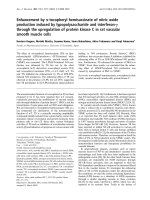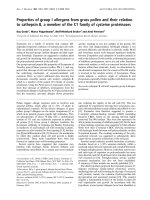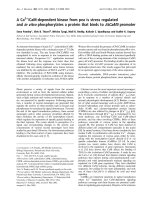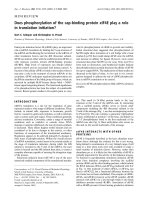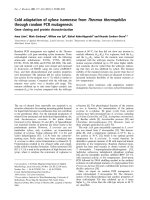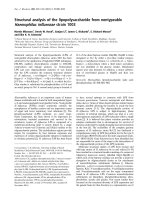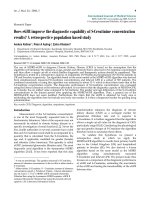Báo cáo y học: "Does Flavanol Intake Influence Mortality from Nitric Oxide-Dependent Processes
Bạn đang xem bản rút gọn của tài liệu. Xem và tải ngay bản đầy đủ của tài liệu tại đây (139.19 KB, 6 trang )
Int. J. Med. Sci. 2007, 4
53
International Journal of Medical Sciences
ISSN 1449-1907 www.medsci.org 2007 4(1):53-58
© Ivyspring International Publisher. All rights reserved
Research Paper
Does Flavanol Intake Influence Mortality from Nitric Oxide-Dependent
Processes? Ischemic Heart Disease, Stroke, Diabetes Mellitus, and Cancer in
Panama
Vicente Bayard
1
, Fermina Chamorro
1
, Jorge Motta
2
, and Norman K. Hollenberg
3
1. Instituto Commemorative Gorgas de Estudios de la Salud and The Department of Preventive Medicine, School of Medi-
cine, University of Panama, Panama City, PANAMA, and Gorgas Institute, Panama City, PANAMA;
2. Instituto Commemorative Gorgas de Estudios de la Salud, Panama City, PANAMA;
3. Brigham and Women’s Hospital, and Harvard Medical School, Boston, Massachusetts, USA.
Correspondence to: Norman K. Hollenberg, M.D., Ph.D., Brigham and Women’s Hospital, 75 Francis Street, Boston, MA 02115. Tel: (617)
732-6682; Fax: (617) 232-2869; e-mail:
Received: 2006.11.28; Accepted: 2007.01.26; Published: 2007.01.27
Substantial data suggest that flavonoid-rich food could help prevent cardiovascular disease and cancer. Cocoa is
the richest source of flavonoids, but current processing reduces the content substantially. The Kuna living in the
San Blas drink a flavanol-rich cocoa as their main beverage, contributing more than 900 mg/day and thus
probably have the most flavonoid-rich diet of any population. We used diagnosis on death certificates to compare
cause-specific death rates from year 2000 to 2004 in mainland and the San Blas islands where only Kuna live. Our
hypothesis was that if the high flavanoid intake and consequent nitric oxide system activation were important the
result would be a reduction in the frequency of ischemic heart disease, stroke, diabetes mellitus, and cancer – all
nitric oxide sensitive processes. There were 77,375 deaths in mainland Panama and 558 deaths in the San Blas. In
mainland Panama, as anticipated, cardiovascular disease was the leading cause of death (83.4 ± 0.70 age adjusted
deaths/100,000) and cancer was second (68.4 ± 1.6). In contrast, the rate of CVD and cancer among is-
land-dwelling Kuna was much lower (9.2 ± 3.1) and (4.4 ± 4.4) respectively. Similarly deaths due to diabetes
mellitus were much more common in the mainland (24.1 ± 0.74) than in the San Blas (6.6 ± 1.94). This compara-
tively lower risk among Kuna in the San Blas from the most common causes of morbidity and mortality in much
of the world, possibly reflects a very high flavanol intake and sustained nitric oxide synthesis activation. How-
ever, there are many risk factors and an observational study cannot provide definitive evidence.
Key words: Cocoa, flavanoids, heart disease, diabetes mellitus, cancer, infectious disease
1. Introduction
The effects of plant flavonoids on mammalian
cells have been of substantial recent interest, with at-
tention focused on the implications of these agents for
cardiovascular disease and for cancer [1]. Some epi-
demiological studies designed to examine a possible
protective effect of flavonoids in cardiovascular dis-
ease have reported inverse associations [2-15]. Incon-
sistencies may be due to measurement error because
foods that are flavanol-rich, such as grapes, red wine,
or cocoa and chocolate shows remarkable variability in
the flavonoid content, largely reflecting processing
[16-18].
The Kuna Indians of Panama are known for their
low blood pressure levels and little rise in blood pres-
sure with age [19-21]. Our interest began with a search
for protective genes, but the protection was environ-
mental rather than genetic [20].
As no environmental
factor identified to date will reduce blood pressure
levels to 110/70 mm Hg -- the average found in the
Kuna, even those over 65 years of age -- identification
of potential environmental factors was of considerable
interest. We learned that Kuna still residing in their
indigenous location in the San Blas islands drank cocoa,
all locally grown, as their major source of fluid. The
cocoa proved to be flavanol-rich [22]. The flavonoids
were shown to cause the activation of nitric oxide
synthase in healthy volunteers and patients with
atherosclerosis [23, 24].
The very high flavonoid intake taken by virtually
all Kuna Indians residing in their indigenous home
area, enjoying what is almost certainly the highest
flavanoid intake of any community, has created an
opportunity to examine the possible role of a sustained
high flavonoid intake on cardiovascular disease and
cancer -- two major contributors to morbidity and
mortality [1]. There are also reasons for suspecting that
flavonoids could protect against diabetes mellitus, as
they improve sensitivity to insulin [25]. We employed
death certificates mandated by the Republic of Panama
for all deaths within the Republic. One cannot be bur-
ied without a completed death certificate. As only
Kuna Indians can own land in the San Blas and all but
a very small fraction of the residents are Kuna Indians,
this allowed us to compare a population characterized
Int. J. Med. Sci. 2007, 4
54
by a very high sustained flavonoid intake with another
population in which flavonoid intake is more variable,
on average much lower. Cocoa obtained in the
mainland from grocery stores is flavanol-poor [18, 22].
Because there are many risk factors for each of these
processes and because death certificates contain little
information on risk beyond age and to avoid poten-
tially spurious evidence on risk, we prespecified that a
significant outcome from this study would demon-
strate a lower frequency of 4 processes in the San Blas
-- ischemic heart disease, stroke, diabetes mellitus, and
cancer. These complex processes have little in common
other than the possibility that flavanols might influ-
ence their development and progression [1].
2. Materials and methods
Death certificates for the years 2000 to 2004 were
available for 77,375 in mainland Panama and 548 indi-
viduals in the San Blas. A single cause of death was
listed by either the attending physician or by a local
health authority. Contributing causes of death were
not listed, nor was ethnicity listed. All of the data were
submitted to the Panamanian Ministry of Health in
Panama City and were available for analysis. The code
of the specific cause of death was based on the detailed
list of the International Class of Occasional Statistics of
Diseases and Problems Related Health Problems (CID
9 and 10).
The age distribution in the San Blas and in the
Panama mainland was obtained from the most recent
census information obtained in the year 2004.
Frequency of deaths per hundred thousand
population were tabulated for various causes of death,
both with and without age-adjustment and relative
risk and 95 percent confidence interval were calculated.
We used the Student’s t-test and Chi Square to com-
pare the frequency of cause-specific deaths in
mainland Panama and the San Blas. Chi square was
used to assess differences in age distribution across the
two regions. We considered a p value of less than 0.05
as statistically significant.
3. Results
In mainland Panama, the most common cause of
death was diseases of the circulation with a frequency
of 119/100,000/year (Table 1). This was made up al-
most equally of ischemic heart disease with a fre-
quency of 43.94/100,000/year and stroke with a fre-
quency of 41.34/100,000/year. The frequency was
somewhat greater in males, 132/100,000/year, than in
females, 106/100,000/year, and as expected showed a
striking increase with age, reaching a peak of
1,193/100,000/year in those over 60 years of age.
Cancer followed with a frequency of
74.71/100,000/year. The frequency in males
(77.6/100,000/yr) exceeded only slightly the frequency
in females (71.8/100,000/yr). Again, rates peaked
among those over 60 years of age, at 620/100,000/yr.
Diabetes mellitus was sixth in frequency with an av-
erage of 24.4 deaths/100,000 with a frequency signifi-
cantly higher in women than in men. The frequency
peaked at 237.6/100,000/yr in those over 60 years of
age.
TABLE 1. Death rate for Panama per 100,000: effect of gender and age
AGES
DIAGNOSIS TOTAL MALE FEMALE 0-10 10-20 20-25 25-35 35-50 50-60 60+
Total 424.76 486.80 361.57 203.51 50.61 109.94 131.72 205.68 485.15 3126.11
CV Disease 119.06 131.99 105.89 2.25 2.82 5.44 6.31 32.15 119.00 1193.65
Cancers 74.71 77.58 71.78 5.40 6.64 7.62 10.71 36.86 135.23 620.18
Accidents 43.53 71.52 15.02 16.80 23.89 63.13 59.65 49.48 42.44 53.01
Respiratory Dis-
eases
40.19
44.16
36.14
21.90
1.99
4.72
3.63
10.94
30.37
351.05
Infectious 31.62 39.48 23.61 24.00 2.32 13.42 31.16 40.56 39.94 108.24
Diabetes 24.40 19.93 28.95 0.30 0.00 0.36 0.57 7.74 33.70 237.62
GI Disorders 17.65 21.55 13.68 2.10 1.16 2.54 2.29 8.92 29.54 146.80
Urinary Sys Dis-
eases
13.87
16.30
11.39
1.80
1.33
0.73
3.06
5.39
18.31
120.85
Unclassified
Symptoms
12.33
13.99
10.63
8.85
0.50
2.90
3.44
2.02
11.23
97.86
Brain Disorders
Excl Strokes
12.17
13.87
10.44
7.80
3.82
2.18
3.63
4.21
13.73
84.52
Perinatal 10.94 12.74 9.10 52.04 0.00 0.00 0.00 0.00 0.00 0.00
Deformities 10.02 11.43 8.59 45.59 1.49 0.36 0.57 0.17 0.00 0.00
Malnutrition 9.80 9.68 9.93 14.70 2.82 3.63 3.25 3.03 7.07 49.67
Subcu & Connec-
Tissue Disorders
3.63
2.56
4.71
0.00
0.66
1.45
1.72
2.69
4.58
26.32
Childbirth Prob-
lems
0.85 0.00 1.72 0.00
0.50 1.45 1.72 1.51 0.00 0.74
Death rates for the 15 most common causes of death in Panama. The effects of gender and age are shown. The leading causes of death are cardiovas-
cular disease, cancer, and accidents as in much of the world.
In the San Blas, the pattern differed strikingly
(Table 2). The most common cause of death in the San
Blas was infections with a frequency of
80.5/100,000/yr. The frequency of death due to infec-
tions was substantially greater in men
Int. J. Med. Sci. 2007, 4
55
(130.1/100,000/yr) than in women (61/100,000/yr).
The age distribution showed two peaks. An early peak
in those under 10 years of age was dominated by di-
arrheal illness in the very young. A secondary peak
occurred in those over 60 years of age. The common
infections, in addition to diarrhea were tuberculosis,
malaria, influenza, and HIV.
In the conditions of interest (Table 2), heart dis-
ease showed a frequency of only 8.3/100,000/yr and
stroke was even lower, with a frequency of
3.2/100,000/yr. Cancer and diabetes were equally low
with a frequency of 3.7/100,000/yr (Table 2).
Four conditions were predetermined before the
analysis to be specific targets for effectiveness of fla-
vanols, heart disease, stroke, cancer, and diabetes mel-
litus. The year-by-year findings in Panama and in the
San Blas for those four conditions are shown in Table 3.
The stability year-by-year for each diagnosis in Pa-
nama was evident. In the case of cancer, the frequency
over the five years ranged from 64.2 to
72.2/100,000/yr with a mean of 68.4±1.60. In San Blas
during the same interval four of five years showed no
cancers, and one year showed a peak of 22/100,000/yr
with a mean of 4.4±4.4 in San Blas: the difference in
frequency is highly significant (p<0.001). A similar
pattern exists for ischemic heart disease and stroke,
each relatively stable in Panama and showing more
variation in San Blas: The frequency in San Blas for
both was significantly lower than in mainland Panama
(p<0.001). In the case of diabetes (Table 3) the same
consistent difference was found, but the difference was
smaller: The frequency in San Blas was 39 percent of
that in Panama. The data are presented by age for these
4 conditions for the most recent year in which data are
available, 2004 (Table 4).
TABLE 2. Death rate for San Blas per 100,000: By Age and Gender
AGES
DIAGNOSIS TOTAL MALE FEMALE 0-10 10-20 20-25 25-35 35-50 50-60 60+
Total Regional 192.82 232.06 158.84 174.42 25.25 88.85 120.30 151.71 139.83 928.25
Infections 80.53 103.14 60.96 62.53 6.31 44.42 75.19 90.38 76.27 336.18
Respiratory
Disease
48.78
55.54
42.93
78.98
6.31
12.69
11.28
12.91
19.07
215.76
GI Disease 11.04 12.89 9.44 1.65 2.10 0.00 11.28 9.68 6.36 75.26
Malnutrition 10.12 11.90 8.59 4.94 0.00 0.00 11.28 9.68 25.42 45.16
Brain Disor-
ders, excl
Strokes
9.66
12.89
6.87
4.94
8.42
6.35
3.76
3.23
6.36
50.18
CV Disease 8.28 9.92 6.87 8.23 0.00 6.35 0.00 3.23 0.00 55.19
Soft Tissue
Disorders
6.90
4.96
8.59
0.00
0.00
0.00
0.00
3.23
6.36
65.23
Diabetes Mel-
litus
3.68
5.95
1.72
0.00
0.00
0.00
0.00
6.46
0.00
30.11
Accidents 3.68 5.95 1.72 1.65 0.00 12.69 7.52 6.46 0.00 5.02
Cancers 3.68 2.98 4.29 0.00 2.10 0.00 0.00 6.46 0.00 25.09
Stroke 3.22 3.97 2.58 0.00 0.00 6.35 6.35 0.00 0.00 30.11
Perinatal Dis-
eases
3.22
1.98
4.29
11.52
0.00
0.00
0.00
0.00
0.00
0.00
Death rate for the San Blas Island Chain per 100,000. A similar presentation to Table 1, but focused on the San Blas Islands off the Caribbean Coast. Note
that cardiovascular disease, cancer, and diabetes are less than 10% of their frequency in the mainland.
TABLE 3. Age Adjusted Death rate/100,000 for selected causes in Panama
YEAR 2000 2001 2002 2003 2004
Mean SD SEM n
IHD*
Panama 42.1 45.5 42.8 44.6 44.7 43.94 1.43 0.64 5
San Blas 8.4 2.8 16.8 8.3 7.0 8.7 6.75 3.02 5
CANCER
Panama 67.9 64.2 65.7 71.8 72.7 68.36 3.58 1.60 5
San Blas 0.0 0.0 0.0 22.0 0.0 4.41 9.86 4.41 5
STROKE
Panama 40.2 40.4 40.0 42.3 43.8 41.34 1.65 0.74 5
San Blas 0.0 0.0 0.0 2.8 0.0 0.55 1.23 0.55 5
DIABETES
Panama 21.8 23.2 26.0 25.2 24.4 24.12 1.66 0.74 5
San Blas 5.6 8.3 11.1 2.8 5.0 6.6 4.33 1.94 5
*ISH=Ischemic Heart Disease
Age adjusted death rates per 100,000 over 5 years for the 4 conditions specified in the hypothesis that a very high dietary intake of flavanoids
might predict. Note the remarkable year-to-year consistency in Panama and the very much lower frequency each year in the San Blas.
Int. J. Med. Sci. 2007, 4
56
TABLE 4. Age Adjusted death rate in Panama and Kuna Yala for 2004
Disease Total/100,000 25-34 Years 35-44 Years 45-54 Years 55-64 Years 65-74 Years 75 + Years
IHD
Panama 44.7 2.5 7.6 19.6 70.8 204.6 1339
Kuna Yala 7 0 0 0 0 1 6
STROKE
Panama 43.8 0 8.8 27.4 96.2 253.4 1143.1
Kuna Yala 0 0 0 0 0 0 0
CANCER
Panama 72.7 10.7 29.9 81.9 187.1 503.3 1220
Kuna Yala 0 0 0 0 0 0 0
DIABETES
Panama
24.4
0
0
0
64.1
172.4
586.8
Kuna Yala 0 0 1 0 0 2 2
Age-adjusted death rate in Panama and Kuna Yala for one year, 2004, for the 4 conditions specified in the hypothesis. Note that in Panama each diag-
nosis shows an age-dependent frequency, and that this does not appear in the San Blas.
Four conditions were predetermined before the
analysis to be specific targets for effectiveness of fla-
vanols, heart disease, stroke, cancer, and diabetes mel-
litus. The year-by-year findings in Panama and in the
San Blas for those four conditions are shown in Table 3.
The stability year-by-year for each diagnosis in Pa-
nama was evident. In the case of cancer, the frequency
over the five years ranged from 64.2 to
72.2/100,000/yr with a mean of 68.4±1.60. In San Blas
during the same interval four of five years showed no
cancers, and one year showed a peak of 22/100,000/yr
with a mean of 4.4±4.4 in San Blas: the difference in
frequency is highly significant (p<0.001). A similar
pattern exists for ischemic heart disease and stroke,
each relatively stable in Panama and showing more
variation in San Blas: The frequency in San Blas for
both was significantly lower than in mainland Panama
(p<0.001). In the case of diabetes (Table 3) the same
consistent difference was found, but the difference was
smaller: The frequency in San Blas was 39 percent of
that in Panama. The data are presented by age for these
4 conditions for the most recent year in which data are
available, 2004 (Table 4).
TABLE 5. Age distribution in San Blas and mainland Pa-
nama
PANAMA SAN BLAS
AGE (Years) MALE FEMALE MALE FEMALE
<55
94.1% 93.9%
88% 86.1%
55-64 3.1% 3.0% 5.8% 6.7%
65-74 1.8% 1.9% 3.9% 4.7%
75+ 1.0% 1.2% 2.3% 2.5%
X
2
= 11.04. df = 1. P<0.001
Age-distribution in the San Blas and mainland Panama from the
census of 2004. Note that there are more individuals over the age of
55 years among the Kuna in the San Blas than mainland Panama,
and the frequency is about double during each decade.
Death from trauma was also more frequent in the
mainland than in the indigenous island location,
largely reflecting the influence of motor vehicle acci-
dents. In the San Blas, there are neither roads nor
automobiles, and death from this source was zero. An
increase in risk in the San Blas was associated with
perinatal medical problems, infections, and all other
causes.
The average age of the Kuna in the islands was
very much influenced by the mortality in the very
young, primarily due to diarrhea. As an index of aging,
we examined the age distribution on the mainland and
in the islands (Table 5). About 12 percent of both males
and females in the San Blas were 55 years of age or
older, about double the 6 percent over that age in the
Panama mainland (Chi Square = 11.04; p<0.001).
4. Discussion
In Panama, as in much of the western world,
diseases of the circulation are the most common cause
of death, and cancer is second. The difference in risk of
death due to these two classes of illness, cancer and
heart disease, between San Blas and mainland Panama
was very large. Our original hypothesis was that this
would be the case if flavanol-rich cocoa and its influ-
ence on nitric oxide synthesis had implications for
disease pathogenesis, as has been suggested [26]. We
could explain this extraordinary difference in the risk
of death by proposing either a better prognosis or a
lower incidence of these illnesses in San Blas. A re-
duced incidence is the most likely explanation, but
both a better prognosis and a reduced incidence could
have a similar explanation.
The San Blas is the oldest indigenous district in
the Republic of Panama, having a relatively homoge-
neous population both biologically and ethnically. It
exhibits one of the highest levels of poverty and eco-
nomic and social exclusion in Panama. The district has
two hospitals, six health centers, and eleven health
posts, which do not guarantee access to all levels of
service. About 40,000 inhabitants are spread over
forty-nine communities that are widely dispersed
along the entire Caribbean Coast of Panama. The pro-
file of health of the Kuna residing in the San Blas re-
vealed substantial premature death due to infections:
Infectious and parasitic diseases made a contribution
more than 4-fold higher than in the rest of the country.
The principle reasons were diarrhea, tuberculosis,
AIDS, influenza, and malaria.
Int. J. Med. Sci. 2007, 4
57
One major limitation of our findings involves
how the diagnosis on the death certificates was estab-
lished. Medical diagnosis follows a well-defined se-
quence in which suspicion is raised from findings ob-
tained from a medical history and physical examina-
tion, followed up with specific tests designed to estab-
lish the diagnosis. In the case of cancer, for example,
examination of tissue obtained at biopsy is required for
diagnosis. In the case of heart disease, the diagnosis
will be established through some combination of
medical history and physical findings supplemented
by the results of tests, including x-ray, angiography,
ultrasound examination, the electrocardiogram, and
occasionally a biopsy. The availability of the laboratory
examination probably differs in the San Blas and the
mainland, but the difference is relative, not absolute. In
the hospital in Ailigandi, for example, an electrocar-
diogram machine has been available for more than
fifteen years, and the physicians who staff the hospital
have worked in Panama City and know how to diag-
nose myocardial infarction. During those fifteen years,
there have been no cases of myocardial infarction di-
agnosed on Ailigandi (personal communication). Dif-
ferences in the ability to establish a diagnosis may have
played a larger role in the frequency of cancer diagno-
sis than in the frequency with which heart disease was
diagnosed, although thousands of Pap smears and
biopsies are performed annually in the San Blas. In 4 of
5 years, no cases of cervical cancer were diagnosed.
Age of the communities at risk is important. As
both diseases of the circulation and cancer increase in
frequency with age, death at an earlier age from infec-
tion could have influenced the outcome. In fact, the
communities living in San Blas are not younger: The
percentage of Kuna who are over the age of 55 years is
substantially and statistically higher than in mainland
communities. Adjustment for age served to enhance
the difference in the frequency with which disease of
the circulation or cancer led to death in the San Blas
versus the mainland.
Although compatible with the possibility that a
diet extraordinarily rich in flavonoids contributed to
the low frequency of circulatory disease and cancer, it
is obvious that other possibilities exist. These include
especially different patterns of diagnosis discussed
above. As another alternative to flavanoid intake to
account for the difference in disease frequency, the
possibility that differences in other risk factors con-
tributed cannot be ignored. Unfortunately, the death
certificates contained none of this information beyond
age. As the difference was so very large, and the ex-
planation is so important, follow-up population-based
studies will be important to examine these risk factors
prospectively. Until such data are available, the results
of this study should be interpreted with great caution.
Other lifestyle variables may play a role in health
outcomes by region. Stress is commonly suspected to
be lower on the islands than on the mainland (com-
monly by people who have actually never visited the
islands). We have assessed stress in the Panamanian
mainland and islands, and there is a difference favor-
ing the islands, but it is small [30]. Another possible
difference is diet. We and others have examined the
diet in the San Blas and Kuna living in the Panamanian
mainland carefully and although several differences
are noted, the most remarkable is cocoa intake [14].
However, we have no information on diet and the
frequency of other risk factors in non-Kuna living in
the Panamanian mainland. Obtaining this information
should have a high priority. There is very probably less
exposure to pollutants in the water and in the air in the
San Blas compared to the mainland, especially for
those inhabitants that live in the city. Tobacco use by
Kuna is limited both in the indigenous island site and
the mainland.
Other variables may influence age-specific death
rates by region. One common practice among the Kuna
involves working on the mainland on a job for a salary
for many years, followed by retirement to the San Blas
indigenous island life where life is less stressful, and
less expensive. To the extent that occurred, and if
twenty or thirty years of life on the Panamanian
mainland do not lead to changes that cannot be re-
versed by return to the island, differences between the
two locations may have been underestimated.
If indeed they do protect, how might the flavon-
oids provide protection? Our hypothesis was that in
the case of vascular disease the responsible pathway
could involve stimulation of nitric oxide synthesis and
thereby reversal of endothelial dysfunction [23, 24].
Alternative possibilities, also possibly related to nitric
oxide, include improvements in insulin sensitivity [25],
improvements in platelet function [15], inhibition of
LDL oxidation [28],
and an increase in plasma HDL
cholesterol concentration [29]. The influence of nitric
oxide on insulin sensitivity would also provide an ex-
planation for the difference in the frequency of diabe-
tes mellitus [25] in the San Blas and the mainland [1].
In addition, a role in carcinogenesis may be hypothe-
sized through nitric oxide cell-to-cell communication
[1].
Death certificates provide core information, es-
pecially important at the national level [31, 32]. The
findings can be misleading. For example, if someone
dies with both cancer and diabetes, the cancer is far
more likely to be recorded [33]. This problem should
not have influenced our findings, as heart attack,
stroke, and cancer are likely to have been chosen from
among a range of possible diagnoses, and there is no
reason why the pattern should differ on the mainland
and in the San Blas.
Despite the other possible explanations for the
large differences in deaths from cardiovascular disease
and cancer with an array of possible confounding fac-
tors, it is improbable that these could abolish the car-
diovascular and cancer protective effect observed
among the San Blas Kuna as compared to the mainland.
Although the findings are compatible with effect of the
flavanol-rich cocoa on health, clearly a large number of
alternative possibilities exist involving diet, physical
activity, stress and genetic factors. An observational
study of this kind cannot prove causality. Indeed, only


